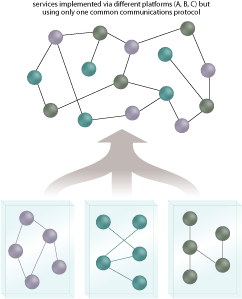CSC/ECE 517 Fall 2009/wiki2 16 rs: Difference between revisions
| Line 17: | Line 17: | ||
==Advantages of SOA== | ==Advantages of SOA== | ||
In architectural terms, a modern architectural design should be Service Oriented, loosely coupled, driven by events, able to support both integration and assembly, aligned with valuable life cycle support processes, and able to leverage existing infrastructure and applications. | |||
When it comes to Service Oriented Architecture, it tends to offer a variety of different advantages over more traditional methods of distributing computing. These include offering business services across several platforms; providing location independence; providing authentication as well as authorization support on ever tier; a loosely coupled approach; and dynamic search and connectivity to other services. At the same time, it allows that services do not have to be located on a particular system or network. | |||
=SOA Patterns Proposed = | =SOA Patterns Proposed = | ||
Revision as of 22:09, 8 October 2009
CSC/ECE 517 Fall 2009/wiki2 16 rs
SOA provides another view of providing functionality based upon services offered in terms of protocols and a specific API. Research and report on what patterns have been proposed and are utilized within this domain. How do they differ from traditional design patterns proposed by Eric Gamma, Richard Helm, Ralph Johnson, and John Vlissides? How are they similar?
Introduction
SOA provides another view of providing functionality based upon services offered in terms of protocols and a specific API. Research and report on what patterns have been proposed and are utilized within this domain. How do they differ from traditional design patterns proposed by Eric Gamma, Richard Helm, Ralph Johnson, and John Vlissides? How are they similar?
This page reviews the different service oriented architecture patterns proposed for protocols and compares them them with the corresponding patterns which were proposed for object oriented reuse.
Service Oriented Architecture-An Overview
Service Oriented Architecture
A service-oriented architecture is essentially a collection of services. These services communicate with each other. The communication can involve either simple data passing or it could involve two or more services coordinating some activity. Some means of connecting services to each other is needed.
Advantages of SOA
In architectural terms, a modern architectural design should be Service Oriented, loosely coupled, driven by events, able to support both integration and assembly, aligned with valuable life cycle support processes, and able to leverage existing infrastructure and applications.
When it comes to Service Oriented Architecture, it tends to offer a variety of different advantages over more traditional methods of distributing computing. These include offering business services across several platforms; providing location independence; providing authentication as well as authorization support on ever tier; a loosely coupled approach; and dynamic search and connectivity to other services. At the same time, it allows that services do not have to be located on a particular system or network.
SOA Patterns Proposed
Canonical protocol
